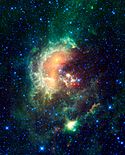(1719) Jens
| ||
 | ||
| Odkrywca | Karl Reinmuth | |
| Data odkrycia | 17 lutego 1950 | |
| Numer kolejny | 1719 | |
| Oznaczenie tymczasowe | 1950 DP | |
| Charakterystyka orbity (J2000) | ||
| Przynależność obiektu | Pas główny | |
| Półoś wielka | 2,6558 au | |
| Mimośród | 0,2221 | |
| Peryhelium | 2,0659 au | |
| Aphelium | 3,2456 au | |
| Okres obiegu wokół Słońca | 4 lata 120 dni 20 godzin | |
| Średnia prędkość | 18,27 km/s | |
| Inklinacja | 14,27° | |
| Charakterystyka fizyczna | ||
| Średnica | 21,610 km | |
| Okres obrotu | 5,87 h | |
| Albedo | 0,085 | |
| Jasność absolutna | 11,7m | |
(1719) Jens – planetoida z pasa głównego asteroid okrążająca Słońce w ciągu 4 lat i 121 dni w średniej odległości 2,66 au. Została odkryta 17 lutego 1950 roku w Landessternwarte Heidelberg-Königstuhl w Heidelbergu przez Karla Reinmutha. Nazwa planetoidy pochodzi od imienia wnuka odkrywcy. Przed jej nadaniem planetoida nosiła oznaczenie tymczasowe (1719) 1950 DP.
Zobacz też
Bibliografia
- (1719) Jens w bazie Jet Propulsion Laboratory (ang.)
- (1719) Jens w bazie Minor Planet Center (ang.)
Linki zewnętrzne
- Diagram orbity (1719) Jens w bazie Jet Propulsion Laboratory (ang.)
Media użyte na tej stronie
As WISE scanned the sky, capturing this mosaic of stitched-together frames, it happened to catch an asteroid in our Solar System passing by. The asteroid, called 1719 Jens, left tracks across the image, seen as a line of yellow-green dots near centre. A second asteroid, designated 1992 UZ5, was also observed cruising by near the upper left.
But that's not all that WISE caught in this busy image -- two satellites orbiting Earth above WISE streak through the image, appearing as faint green trails. The apparent motion of asteroids is slower than satellites because asteroids are much more distant, and thus appear as dots that move from one WISE frame to the next, rather than streaks in a single frame.
This Tadpole region is chock-full of stars with ages as young as only a million years -- infants in stellar terms -- and masses over ten times that of our Sun. It is called the Tadpole nebula because the masses of hot young stars are blasting out ultraviolet radiation that has etched the gas into two tadpole-shaped pillars, called Sim 129 and Sim 130. These "tadpoles" appear as the yellow squiggles near the centre of the frame. The knotted regions at their heads are likely to contain new young stars.
Twenty-five frames of the region, taken at all four of the wavelengths detected by WISE, were combined into this one image. The space telescope caught the 1719 Jens in 11 successive frames. Infrared light of 3.4 microns is color-coded blue: 4.6-micron light is cyan; 12-micron-light is green; and 22-micron light is red.